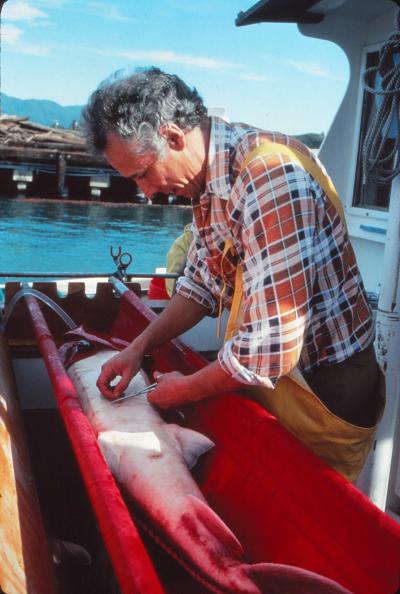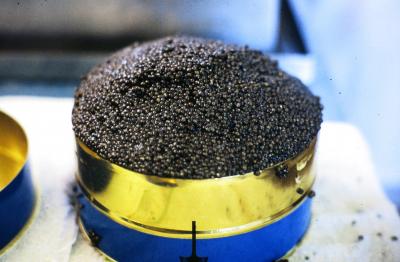While some might have side-eyed the New York Times’ recent suggestion to slather a dollop of caviar over warm cheese steaks or to pile the eggs atop zesty Doritos, there are surprising reasons to be on board with the briny delicacy’s expanding reach.
Today’s abundance of caviar is no accident. It’s an aquaculture success story in disguise, and one that stretches back four and a half decades to sleepy Sacramento — an unlikely California inland city deemed America’s caviar capital, thanks in part to steady years of California Sea Grant research funding.
Once reserved for special occasions, caviar has historically been paired with a side of quiet handwringing over the increasingly troubling conditions for the wild sturgeon populations that supplied it. By the time Russian-born Serge Doroshov made his way to the University of California, Davis, in 1979, California’s white sturgeon populations were already in trouble.
Most of the marine species humans have decided to farm — including oysters, shrimp, salmon, trout and bass — are relatively fast growers, ready to harvest in two years or less. On paper, sturgeon seemed an unlikely candidate for aquaculture. Throwbacks to the dinosaur era, bony-looking sturgeon are slow growers that can reach up to 20 feet and a whopping 1,500 pounds, making them unwieldy for growers to handle; plus, wild females need 15-20 years before they’re ready to reproduce. Nonetheless, a confluence of events in the early 1980s changed this fish’s fate.
It’s not a stretch to say the challenges for domestication of California’s white sturgeon were formidable, but Doroshov was determined to build the industry. California Sea Grant helped him do just that.
The Launch of an Industry
Doroshov, widely considered the “father of sturgeon aquaculture” (or as others called him: “the Baryshnikov of marine biology”), made a bold move to get to California.
Previously the director of what is today called the Russian Federal Research Institute of Fisheries and Oceanography, Doroshov’s reputation was widely known, and by 1975, he was working for the U.N.’s Food and Agriculture Organization (FAO) as an aquaculture expert.
While in Cuba working on marine fish breeding, Doroshov saw an opportunity to make a daring escape with his wife and two children. Instead of traveling directly back to Russia, Doroshov was given permission to make a stop in Rome to drop off a report at the FAO headquarters. While there, the family fled to the U.S. Embassy where they were granted asylum and eventually found their way to the U.S.
After a brief stint at the University of Washington, Doroshov settled into a faculty position at UC Davis, where he taught courses in fish production and reproductive physiology. That’s where the critical work on California’s white sturgeon took off.

Research Begins
Globally, sturgeon populations were under threat of overfishing, while recovery efforts were hindered by a thriving global black market. In the late 1970s, most of the caviar Americans enjoyed was imported from Russia and Iran. But Iran’s upheaval and then-President Jimmy Carter’s economic sanctions blocked a significant portion of the caviar market. As the Soviet Union began to collapse, so too did the management of the fishery in the Caspian Sea, leaving global markets in short supply of legally acquired roe.
As this was happening, Doroshov was able to secure funding to investigate white sturgeon’s reproductive biology in an effort to develop successful hatchery techniques for wildlife enhancement — much like the U.S. was already doing with salmon hatcheries, says Joel Van Eenennaam, a former research associate for Doroshov at UC Davis.
But where to begin?
Doroshov gathered a team that included biologists, engineers, economists, nutritionists and nearby fish farmers who could house the large fish. The U.S., though, had already placed state-by-state, river-by-river prohibitions on sturgeon catches.
To launch their research, the team first needed permission from the California Department of Fish and Wildlife (CDFW) to collect wild sturgeon from nearby waterways to use as broodstock on farms. They also needed the assistance of local commercial fishermen who knew how to target, catch and carefully handle the fish.
“The trick is, how do you collect the spawners? Initially, we didn’t even know where the sturgeon were or how to catch them,” said Ken Beer, then a graduate student of Doroshov, now president and owner of The Fishery, one of the largest producers of females for caviar in North America.
“It was like capturing a moose and trying to raise it like a cow,” Beer said.
With the help of funding from California Sea Grant, the Western Regional Aquaculture Center, CDFW, the National Marine Fisheries Service and others, Doroshov and his team began the work of developing reliable culturing techniques for California’s white sturgeon and figuring out how to set up a prototype hatchery.
“Everyone working on the project was energized from the get-go,” said Paul Olin, former extension director of California Sea Grant. “There was a palpable sense of excitement and passion around bringing this animal into domestication that basically could be something that’s farmed in California while helping to sustain wild populations. It was a win-win.”
Next, the team turned to challenges such as figuring out the ideal water temperatures to spur growth, how to incubate and hatch eggs, and determining what feed the newly farm-bred sturgeon could thrive on that would be comparable to their natural scavenging instincts.
The Soviet Union had already established sturgeon hatcheries to prop up wild populations, says Peter Struffenegger, who led sturgeon farming efforts at Stolt Sea Farm (now Sterling Caviar) for over 30 years.
“But there was no technology at the time that took the fish from fingerling to adult,” he said.
It turns out the groundwater used on the farms to hold and grow the sturgeon was an important factor in getting the females to mature more quickly, and Sacramento’s steady water temperature of 66 to 68 degrees was ideal. Instead of the 15 to 20 years needed to mature in the wild, Dorshov and his team discovered female white sturgeon could mature in as little as seven years.
“It took a few years to figure out how to stage final maturation,” Van Eenennaam said. “Each female has its own internal reproductive clock. You have to follow individual tagged females, just like cattle, to find out when they’re ready to spawn. That’s one reason why sturgeon aquaculture is a bit more complicated than species like catfish or trout.”

Bolstered by continued funding from California Sea Grant and other sources, the team’s efforts progressed. Techniques were developed for enhancing the reproductive performance of sturgeon broodstock. Ultrasounds were used to determine the sex of the fish — females were kept for egg production while males were used to provide sturgeon meat to the market. A genetic map was developed to provide pedigrees for the farmed sturgeon and to confirm the sustainability of the breeding program. Solutions for improving water conditions were developed. Much of what was learned was widely shared to boost other wild sturgeon populations and launch similar aquaculture and conservation efforts.
The decades of work by Doroshov and his team opened the door to the domestic production of caviar and put Sacramento on the map as its U.S. capital and on par with other producers like Germany, France and Poland. But the techniques were also replicated in China, which has become the global leader in caviar production, supplying nearly 40% of the world’s supply in recent years.
Doroshov’s idea to build a sturgeon aquaculture industry that could produce enough caviar to meet global appetites succeeded.
“It all began with us and this program,” Van Eenennaam said. “And Sea Grant was an integral source of funding to help create this whole successful story.”
About California Sea Grant
NOAA’s California Sea Grant College Program funds marine research, education and outreach throughout California. Headquartered at Scripps Institution of Oceanography at the University of California San Diego, California Sea Grant is one of 34 Sea Grant programs in the National Oceanic and Atmospheric Administration (NOAA), U.S. Department of Commerce.